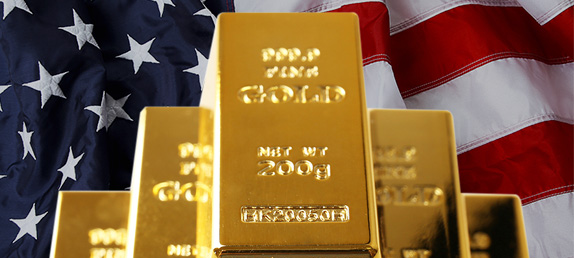
One of the nation’s most successful businessmen, Steve Forbes, has written a new book. In it, the former presidential candidate suggests that a return to a “gold standard” is the only way to prevent a total economic meltdown due to the Federal Reserve’s “loose dollar policy.”
Fox Business has recommended Forbes’ new book, Money: How the Destruction of the Dollar Threatens the Global Economy – and What We Can Do About It, as a “must-read.” They quote Forbes’ dire prediction: “The U.S. central bank’s vastly misguided monetary policies are now setting the stage for a new economic and social catastrophe – one that could rival the financial crisis and horrors of the 1930s.”
The solution: a return to the gold standard. According to Forbes, a gold standard would “lower interest rates and provide for cheaper capital, leading to gangbuster growth.” Forbes believes that “if the American economy had the growth rate it once achieved under a gold standard, it would be three times – instead of two times – the size of the Chinese economy today.”
👉 Related reading: The Gold Standard: Everything You Need to Know
Forbes, along with other gold standard supporters, believes that the current unstable state of the economy is due to reckless spending. Tying the dollar to gold would create accountability and end the secret, opaque monetary policies that are only understood and administered by an elite, powerful few.
Fox Business points to recent financial headlines, believing that they represent a nation crying out for a policy shift:
- “Today, 56% of the world economy has zero-interest-rate policies.”
- “In 2000, the U.S. dollar made up 71% of all reserves held by governments around the world. Today it accounts for just 62%.”
- “The International Monetary Fund estimates that central banks held $10.8 trillion in assets at the end of September, more than four times as much as global hedge funds.”
- “The wide consensus entering the year of Fed tapering equaling a stronger U.S. dollar has not come to fruition because on the stage of QE, the Fed’s balance sheet is only exceeded by the Bank of Japan as a percent of GDP.”
A change has been slow to occur mainly because inflation has been held in check. However, economists are warning that this will quickly change once the trillions of dollars in Fed-created bank reserves come spilling back into the economy. The subsequent inflation could be a game changer.
Fox Business points to higher commodity prices, specifically food-price spikes, believing that they are the “canary in the coal mine” for inflation. They also find irony in the current fight for a higher minimum wage, since the “very same minimum wage would be undercut by a devalued dollar.”
The Federal Reserve never intended Quantitative Easing (QE) to be a long-term fix. It was intended to stabilize the economy, at which point the program would be slowly tapered. Now that the tapering has begun, experts are beginning to worry that consequences of such a dramatic action are going to surface.
The Financial Times has recently reported that the Fed’s “easy money” policy has turned the markets into a house of cards with no real economic foundation. They state that “the hunger in the markets for yield is as voracious as ever,” and this has led investors to put huge sums of money into junk bonds and debt. The Financial Times warns that “The performance of junk debt and equities suggests both markets are being driven less by economic fundamentals than by easy money.”
Previously, the Federal Reserve could combat impending inflation by increasing the fed funds rate (the rate at which banks can get short term loans from the Federal Reserve). Economist Martin Feldstein believes that this strategy is no longer viable because the Fed’s money printing has filled bank reserves, making it unlikely they will need to borrow.
Even though Forbes’ suggestion of a return to the gold standard could be used to subdue inflation, the switch would make the conversion a monumentally difficult task. Not only is the U.S. economy tremendously large, it is also unbelievably complex.
According to analysts contacted by Fox Business, “in order to get back the dollars now in circulation and on deposit – about $2.7 trillion – with approximately 261 million ounces of gold held by the U.S. government, gold prices would have to rise as high as $10,000 an ounce, risking huge inflation in the tricky conversion period.”
However, Forbes addresses this issue in his book. He claims that the monetary base would shrink to $325 billion, and the value of the dollar would soar, making the higher gold prices tolerable. He also suggests that inflation fears could be reduced by use of a gold-based currency board (a basket of currencies). He points to Hong Kong, Denmark, Lithuania, and Bulgaria as examples of economies that use a currency board, which includes euros and euro-bonds along with gold, to back their own money.
Forbes also tries to quell the fear that a gold standard is “unwavering and strict.” He writes, “Gold is far less rigid than people realize. It is both flexible and stable. A gold standard no longer means a fixed supply of money than a use of the metric system means there has to be a fixed number of rulers.”
The price of physical gold made a jump back over $1,300 an ounce this week, closing Friday at $1,314.26 an ounce.


